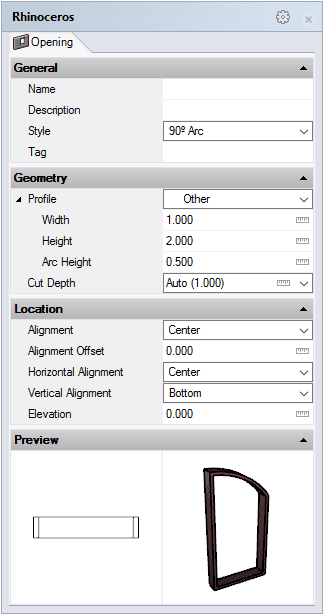Opening
The behavior of openings is identical to that of windows and doors.
Openings can be inserted in a wall or a curtain wall object or as floating objects. In the first case, both elements are anchored and the opening is generated automatically in the wall/curtain wall where it is inserted. Openings can be detached from walls/curtain walls by moving them outside of their surface limits.
Insert an Opening
After running the vaOpening command, the opening insert dialog box will appear. This dialog box shows a list of all object parameters and a preview in 2D and 3D of the style selected.

Opening insert dialog box
The steps required to insert an opening depend on the insertion options selected.
Steps:
- Select the Opening style you wish to use and define the basic insertion options.
- Select the Opening insertion point with a left-click on the desired point in the model. If that point is near to a wall/curtain wall path, the opening will be automatically inserted in that wall/curtain wall.
- Specify the opening orientation manually with the cursor. (This step is not required when the opening has detected a wall or a curtain wall).
- Specify the Opening side by clicking on the desired side of the wall/curtain wall or the opening position. This step is not required when you insert an opening with the offset option.
You can enter as many openings as you wish and you can cancel the command by pressing ENTER or ESC.
In the two insertion options, the opening is automatically generated in the wall/curtain wall as soon as it detects the wall/curtain wall path.
NoteThe opening will not be visible nor select-able in the model if its style has no component and it has been inserted without being attached to a wall/curtain wall.
Opening from curve
Openings can be created from curves, which determine their shape profile.
Steps:
- Run the vaOpening command.
- Select the Opening style you wish to use and define the basic insertion options.
- Select the FromCurves option in the command line.
- Select a curve (or several curves) in the model. This curve must be closed and vertical.
The opening will be generated at the selected curve and will only be inserted in a wall/curtain wall if it is close enough.
NoteThe curves selected to create openings don't need to be oriented parallel to the wall/curtain wall where the openings will be placed. Openings are inserted and oriented automatically according to the closest wall/curtain wall position.
Control points 

Openings have four control points of two types:
- Opening side: this control point is useless, since openings have no leaves.
- Left, Center and Right insert point.
To move the opening (either in the wall/curtain wall or to a different wall/curtain wall), select it from any point and drag it to the desired location.
Openings can only be selected from the VisualARQ Top view.
- Use the vaProperties command, then select an opening and press Enter, or
- Click on
 ,
then select an opening and press Enter, or
,
then select an opening and press Enter, or - Select an opening and open the context menu by pressing the right mouse button for a while then select Opening > Properties, or,
- Double click on an opening object.
Insertion options and parameters
All the opening insertion options and parameters can be edited in the Object Properties
dialog box  or in the VisualARQ Properties section (in Rhino Properties
Panel
or in the VisualARQ Properties section (in Rhino Properties
Panel  ).
).
General
- Type: opening.
- Name: a field to distinguish the opening from other openings.
- Description: a field for custom notes.
- Style: list of opening styles available in the document.
- Tag: reference text that appears in the tag object.
Display
Isocurves and Plan visibility settings for the opening display in 3D and plan views.
Geometry
- Opening calculated measurements: volume and area.
- Profile: shows a list of predefined profiles stored at the opening style. When the profile is set to Other, you can define new values for the profile shape of the selected style.
- Cut depth: value by which the opening will generate an opening in the wall. The Auto value is calculated as an appropriate value to ensure the opening will generate an opening all the way through the wall.
Location
- Position: change the opening insert points from the Point icon
 .
.
- Alignment: openings can be aligned with three methods within the wall/curtain wall thickness

Interior 
Center 
Exterior
- Alignment offset: distance from the opening insert point to the wall path.
- Horizontal Alignment: position of the opening insert point according to its profile shape.
- Left
- Center
- Right
- Vertical Alignment: opening insert point in relation with its vertical distance to the base line of the wall/curtain wall:

Bottom: reference distance between the base line of the wall/curtain wall and the bottom surface of the opening. 
Top: reference distance between the base line of the wall/curtain wall and the top surface of the opening.
- Elevation: the opening elevation in the insert dialog is measured in relation to the baseline of the wall/curtain wall it is inserted in, regardless of its level. After the opening has been inserted, its elevation value indicates the opening position in the world Z coordinates, regardless of the wall/curtain wall and the level where it is inserted. The default elevation value for doors is 0.
Opening
- Opening side: changes the opening opening side from the same side of the wall/curtain wall. The opening side can be also changed from the opening Control points.
 left click
[
left click
[